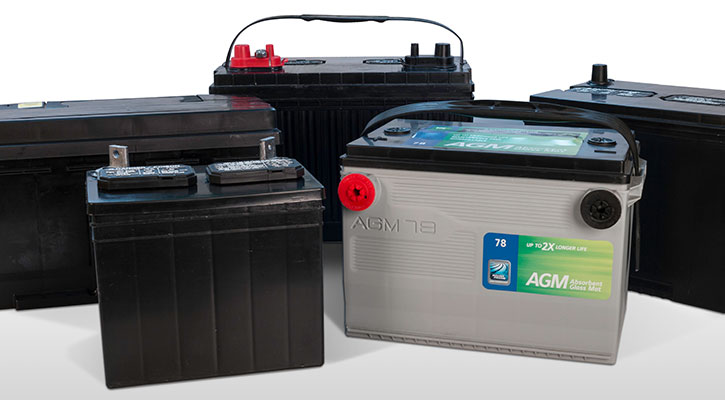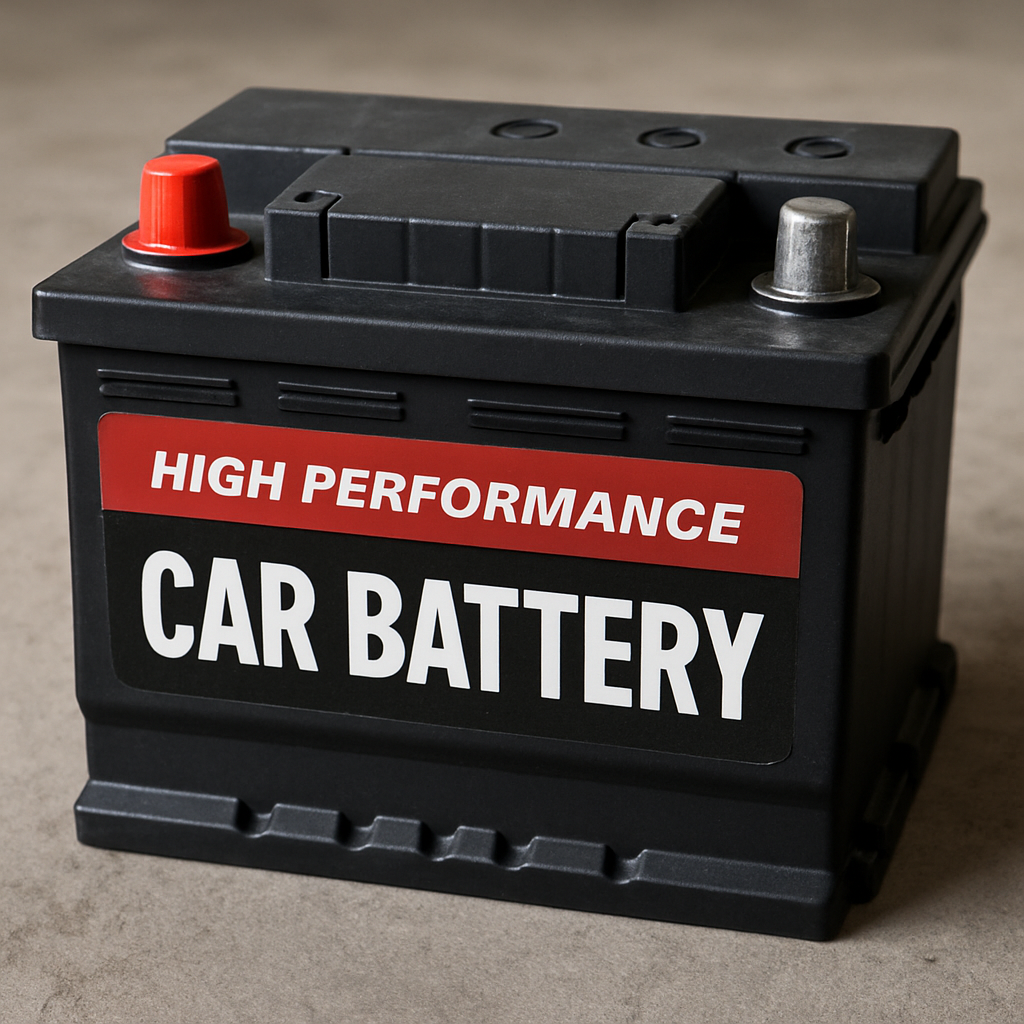Different battery types

Starter batteries
Starter batteries are used when starting fuel engines that require a large current for a short time. Starter batteries are less suitable for operating other equipment. Starter batteries are available in SMF, Gel, AGM, Lithium, and EFB versions:
SMF batteries– Maintenance-free normal battery with liquid electrolyte in a sealed vessel with a safety valve against overpressure. For standing mounting.
Gel batteries- Maintenance-free battery where the electrolyte is bound in jelly. Lacks safety valve and can therefore be mounted both horizontally and vertically.
AGM batteries– Maintenance-free battery where the electrolyte has been bound in a mass of broken glass. The battery type can handle more charging and discharging than the normal battery, and is therefore particularly suitable for cars with Start / Stop technology or that are started often. Can be mounted horizontally or vertically.
Lithium batteries– Maintenance-free battery with higher capacity, lower self-discharge and lower weight than acid batteries of equivalent size. Can be mounted horizontally or vertically.
EFB batteries– Maintenance-free battery with liquid electrolyte in a sealed vessel with safety valve against overpressure. This type of battery has twice as much cycling resistance compared to a standard SMF battery. The EFB battery is specially developed for vehicles with Start / Stop systems. For standing mounting.
Leisure batteries
battery The leisure battery is designed to power electrical equipment and is unsuitable as a starter battery. Available in SMF version.
Lead
accumulator The lead accumulator is used in larger toys or as a backup in various facilities. A fully encapsulated battery that can be mounted horizontally or vertically.
Which battery should I choose?
In addition to batteries being manufactured for different purposes, they also vary in size, design and capacity depending on where they are to be used. The electrical volume of a battery is stated in Ampere hours (Ah), and in the case of starter batteries where the size of the starting current is important, it is stated in CCA (Cold Cranking Amps).
Passenger car and truck batteries
For one and the same car model, there may be several battery options depending on the car’s equipment level. Generator and battery have been dimensioned together accordingly. Therefore, it is important to maintain the balance between generator and battery if you are going to buy a new battery for your car.
It is thus a good rule to choose a battery with the same physical design, number of ampere hours and size of starting current as the old one. For example, there is no advantage in choosing a battery with significantly higher Ampere Hour metal, as this takes longer for your generator to recharge and you risk starting problems when cold.
Motorhome and Caravan batteries
If the motorhome is equipped with a single battery, select a starter battery or a motorhome battery. If, on the other hand, it is equipped with several batteries, choose a starter battery for the engine start and one or more leisure batteries for the consumers (living area).
For caravans, leisure batteries with properties that comply with the manufacturer’s recommendations are used. If the caravan is equipped with charging by sun or wind power, you must use special batteries that can withstand such a low charging current without being damaged.
Motorcycle batteries
In a motorcycle, the space for the battery is often severely limited. Therefore, choose a battery that in dimensions and capacity corresponds to what the manufacturer recommends.
If the battery is mounted horizontally, you can choose a Gel or Lithium battery. If the battery is mounted upright, you can also select SMF.
Boat batteries
In smaller boats with only one battery, use a starter battery or marine battery. For larger boats with several batteries, use a starter battery for the engine and recreational batteries for consumption.
If the boat is equipped with charging from solar cells or wind power, the leisure batteries must be of a type that is suitable for this. A possible bow thruster should advantageously be powered by its own AGM-type battery. For your safety, a boat with several batteries must be equipped with a isolating relay that ensures that the starter battery is always fully charged.
Assembly and connection
Mount the battery firmly anchored in the car’s holder, or in a special battery compartment. In a motorhome, caravan or boat, the battery compartment must be well ventilated and separated from other electrical equipment. However, it does not need to be drained as maintenance-free batteries do not normally emit any liquid. Before connecting the battery, it is important to first clean the poles and cable lugs – oxidized or damaged connections can reduce the battery’s power by up to 25%. Polish the contact surfaces shiny with a pole brush or emery cloth and then lubricate with battery pole grease.
Use and care
The normal life of a rechargeable battery is about 4-5 years, but if you take care of it properly, it can live much longer. Batteries feel best from regular work – a battery that rests for a long time dies away. Batteries should also not be deep discharged (below 12 V) as it causes oxidation of the electrical plates, which greatly impairs the life and capacity of the battery.
The battery bank in a boat or caravan should be supplemented with a battery protection that cuts off the power to the consumers before the voltage becomes too low. Batteries that are idle for more than five weeks, such as boat, motorcycle or caravan batteries, should be stored cool but frost-free and recharged once a month. Feel free to use a maintenance charger that continuously monitors and recharges the battery.
A fully charged battery has a resting voltage of about 12.7 V.
A semi-charged battery has a resting voltage of about 12.2 V.
A discharged battery has a resting voltage of about 11.7 V.
Charge
Charge the battery on a soft surface in a well-ventilated area. Modern batteries are normally tight, but if the battery is damaged or if a misaligned, incompatible or broken charger is used, the battery may overheat and release hydrogen through the safety valve. Hydrogen together with the ambient air forms explosive gas which is very explosive. Therefore, in connection with charging batteries, no other electrical equipment may be used in the same room. When it comes to choosing chargers, there are, in addition to chargers for Lithium batteries that require their own type of charger, booster, traditional charger and intelligent charger.
A booster is a powerful fast charger for one or more batteries. The charger type is used in workshops for emergency charging and is not suitable for normal charging because fast charging wears heavily on the battery. The booster can be used for SMF and AGM batteries.
– A traditional charger can be used for SMF and AGM type batteries but not for Gel batteries. It is cheaper and slightly faster than an intelligent charger, but you must stop charging yourself when the battery is fully charged, otherwise there is a risk of damage.
– An intelligent charger can be used for SMF, AGM and Gel batteries. It adjusts the charging current to the battery and interrupts charging when the battery is full. The charger can also be used for maintenance charging of seasonally used batteries.
Regardless of the type of charger you choose, it should be dimensioned according to the number of ampere hours on your battery. In the product text for each battery charger, you will find a specification of the battery capacity.
Questions and answers
What are Ampere Hours (Ah)?
Ampere hours (Ah) indicate the amount of current (capacity) that a battery can emit. For starter batteries, the capacity is measured during a 20-hour discharge at 25 ° C to a final voltage of 10.5 V.
What does CCA mean?
CCA means “Cold Cranking Amperes”. It is a measure of the current a fully charged cooled battery can deliver at -18 ° C for at least 30 seconds before the battery reaches a voltage as low as 7.2V. When measuring brand new batteries, the CCA value will often be about 20% below the specified. Only after a couple of weeks of use has the battery reached its full capacity and the CCA value corresponds to that specified by the manufacturer. CCA is measured in several scales.
What is the correct charging voltage?
In a car, the charging voltage measured on the battery’s poles should be about 14.4V at 25 ° C, and in a 24-volt system twice as high, ie about 28.8V.
When is a battery fully charged?
A fully charged battery maintains a resting voltage of 12.7 Volts. The acid weight is then 1.28. A discharged battery maintains an idle voltage of 11.7 Volts. The acid weight is then 1.20. If a battery is at a charge of 50% (12.4 V) or less for an extended period of time, the battery will begin to sulfate (see below) and be destroyed. It is important that a battery that has a charge rate of 50% or less is charged as soon as possible.
What does sulphation mean?
Sulphation is what happens when the battery rusts. The risk of sulphation increases the more discharged a battery is. The only way to avoid sulfation is to charge the battery regularly. In this way, the battery has a longer life. When the battery is discharged, the lead and lead oxide that were previously present on the battery’s lead plates change to lead sulphate. This lead sulphate in turn forms water which dilutes the battery acid. The formation of lead sulphate is a natural part of the process in a battery. When the battery is charged, the sulphate is recreated to lead, lead oxide and sulfuric acid. If the battery is left discharged, the crystals of lead sulphate grow in a different way and so much that they cannot be recreated during charging. A sulphation has then taken place and the battery is usually destroyed.
Why does the battery get hot when charging?
A probable reason for the battery becoming hot is that the battery has been discharged and thus partially sulphated. If the battery does not work after charging, it must be replaced.
What happens if you connect a battery inverted?
Damage to the electrical system immediately occurs as the diodes in the generator are destroyed. Therefore, be extremely careful when mounting the battery as the consequential damage of a pole reversal is often very costly to repair.
Can a battery explode?
For batteries to explode, there must be an external influence that ignites the hydrogen gas contained in the battery. In the event of an explosion, the battery has generally been charged, but not sufficiently ventilated before the charger has been removed. Static electricity is a common cause of hydrogen gas ignition. Be careful with cover jackets and synthetic materials – especially in dry winter air. Switch off the charger and wait a few minutes before disconnecting the charger’s battery terminal blocks.
The battery has swelled or cracked, why?
Option 1: The battery has been discharged and has thus been able to freeze. The fluid in the battery has expanded and cracked the sides. A fully charged battery first freezes at -67 ° C while a discharged freezer already at -5 ° C.
Option 2: The battery has probably been discharged and sulphated. The sulfur in the battery acid has then stuck to the plates. When charging the battery, the sulfur has nowhere to go except up the sides.
Option 3: The battery has become overcharged. The heat causes the sides of the battery to become hot and the plastic to give way.




